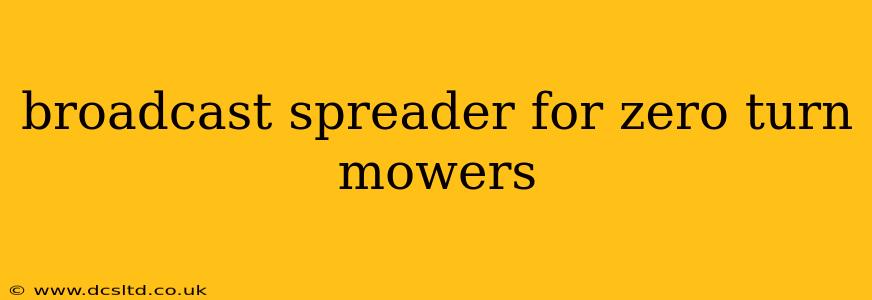Choosing the right broadcast spreader for your zero-turn mower can significantly impact the efficiency and effectiveness of your lawn care. This guide will help you navigate the options and find the perfect fit for your needs. We'll cover various types, features, and considerations to ensure you make an informed decision.
What is a Broadcast Spreader?
A broadcast spreader is a piece of equipment that distributes granular materials like fertilizer, seed, or ice melt evenly across a surface. When paired with a zero-turn mower, it allows for efficient and consistent coverage of large areas, saving you significant time and effort compared to manual spreading.
Types of Broadcast Spreaders for Zero-Turn Mowers
Several types of broadcast spreaders are compatible with zero-turn mowers. The best choice depends on your budget, the size of your lawn, and the materials you plan to spread.
-
Pull-Behind Broadcast Spreaders: These are towed behind the zero-turn mower and are generally larger capacity spreaders ideal for larger lawns. They offer excellent coverage and are often preferred by professionals.
-
Hitch-Mounted Broadcast Spreaders: These spreaders attach directly to the mower's hitch. While offering a compact design, their capacity might be smaller than pull-behind models.
-
Handheld Broadcast Spreaders (for smaller lawns): Though not directly attached, handheld spreaders can supplement a zero-turn setup, especially for smaller, more intricate areas or for applying different materials.
Key Features to Consider When Choosing a Broadcast Spreader
Several features differentiate broadcast spreaders. Consider these factors when making your purchase:
-
Hopper Capacity: Larger hoppers mean fewer refills, increasing efficiency, especially for large lawns.
-
Spread Width: A wider spread width covers more ground per pass, reducing the time it takes to treat your lawn.
-
Calibration: Accurate calibration ensures even distribution, preventing over- or under-application of materials. Look for spreaders with easy-to-use calibration systems.
-
Material Compatibility: Ensure the spreader is compatible with the types of materials you intend to use (fertilizer, seed, etc.).
-
Durability and Build Quality: Invest in a durable spreader built to withstand the rigors of regular use. Look for rust-resistant materials and a robust construction.
How to Properly Calibrate a Broadcast Spreader
Proper calibration is crucial for even distribution and efficient material usage. Most spreaders come with instructions. If you're unsure, consult the manufacturer's guide or look for online tutorials specific to your model. Improper calibration can lead to wasted materials and potential damage to your lawn.
What are the benefits of using a broadcast spreader with a zero-turn mower?
Using a broadcast spreader with a zero-turn mower offers several significant advantages:
- Increased Efficiency: Cover large areas quickly and efficiently.
- Even Distribution: Achieve consistent coverage, preventing uneven application of materials.
- Reduced Labor: Significantly reduces the physical effort required for manual spreading.
- Improved Lawn Health: Precise application of fertilizer and seed promotes healthier, more vibrant lawns.
What size broadcast spreader do I need for my zero-turn mower?
The ideal size depends on the size of your lawn and the capacity of your zero-turn mower's towing capacity (if using a pull-behind model). Larger lawns benefit from larger-capacity spreaders, while smaller lawns may find smaller models more suitable. Always check your mower's owner's manual for towing capacity limits.
Can I use a broadcast spreader with any zero-turn mower?
Most zero-turn mowers can accommodate a broadcast spreader, either through a hitch or by towing. However, it's essential to check your mower's owner's manual to confirm compatibility and towing capacity before purchasing a spreader. Some smaller zero-turn mowers may not have the capacity to tow larger spreaders.
Are there any safety precautions I should take when using a broadcast spreader with my zero-turn mower?
Always follow the manufacturer's instructions for both the spreader and the zero-turn mower. Wear appropriate safety gear, including eye protection and gloves. Be mindful of the spreader's width to avoid overlapping or missing areas. Always operate the equipment safely and responsibly.
This comprehensive guide should provide you with a solid foundation for selecting the right broadcast spreader for your zero-turn mower. Remember to carefully consider your specific needs and budget when making your choice. Happy spreading!
